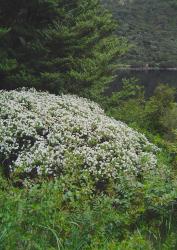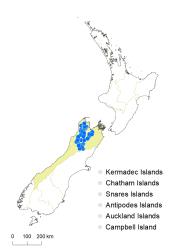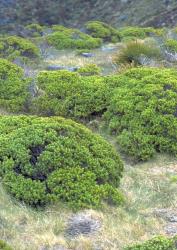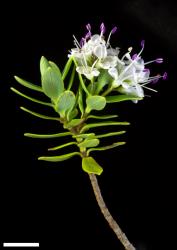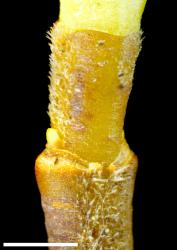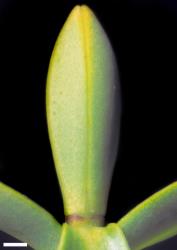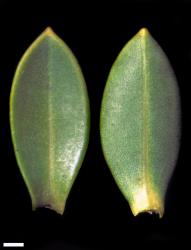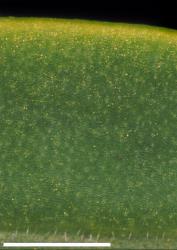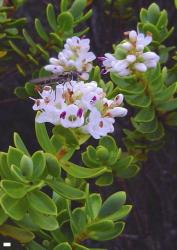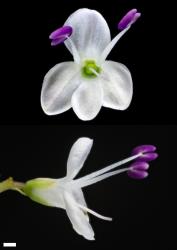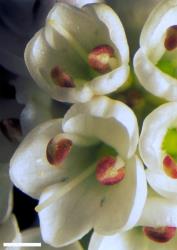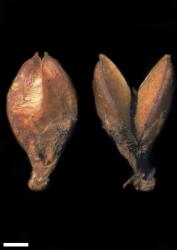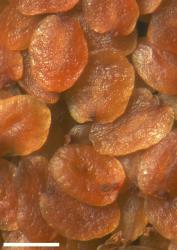- ≡ Hebe topiaria L.B.Moore in Allan, Fl. New Zealand 1, 917 (1961)
Shrub, often neatly rounded, to 1.2 m (rarely to 2.0 m) tall. Stems erect, eglandular-pubescent; hairs usually bifarious or rarely uniform. Leaf bud distinct, its leaves appressed at margins until fully grown; sinus absent. Leaves opposite-decussate, erect to erecto-patent; lamina coriaceous, narrowly elliptic to elliptic to obovate, 5–23 mm long, 3–8 mm wide, dull glaucous to glaucescent above, glaucous beneath; midrib and sometimes 2 secondary veins evident; surfaces glabrous except for eglandular hairs along midrib; margin minutely papillate or rarely ciliate, entire; apex obtuse to acute to apiculate; base cuneate; petiole absent or indistinct and broadly winged, 0–1 mm long. Inflorescence a lateral raceme, 10–40 mm long; flowers crowded, 9–33, female or bisexual on separate plants, ⚥ > ♀; bracts alternate or lowest pair opposite, elliptic to narrowly deltoid, ≥pedicels; pedicels erecto-patent, 0.5–2.5 mm long, eglandular-pubescent all around. Calyx lobes 4, obtuse to acute, 1.5–2.5 mm long, equal, mixed glandular- and eglandular-ciliolate. Corolla 4.0–7.5 mm diameter; tube white, 1.5–2.5 mm long, ≥calyx, eglandular-hairy inside; lobes 4, white, erecto-patent to spreading, sub-equal, elliptic to orbicular, 2.5–4.0 mm long, obtuse or rounded; nectar guides absent. Stamen filaments white, 3–6 mm long; anthers magenta. Style glabrous, 3.5–6.5 mm long. Capsules latiseptate, sub-acute, glabrous, 4–5 mm long, 2.5–3.5 mm at widest point. Seeds discoid to ellipsoid or irregular, flattened, smooth, brown, 1.2–2.0 mm long.
V. topiaria plants can be distinguished from almost all other species by the combination of their neat, rounded habit, small, glaucous leaves, and absence of a sinus in the vegetative bud.
V. glaucophylla plants can have similar leaves and also lack a sinus, but usually have more open branching, corolla tubes shorter than the calyx, and hairy ovaries and capsules.
South Island: Western Nelson, Sounds Nelson, Marlborough, Westland (from near Boulder Lake in the north-west, Richmond Range in the north-east, and Amuri Pass and Poplars Range in the south).
Shrubland and tussock grassland above tree line. Recorded elevations range from 762 to 1462 m.
Flowers: December–February, sometimes to April; fruits: February–May.
2n = 122 (see Bayly & Kellow 2006, as Hebe topiaria).
Veronica topiaria is classified in V. subg. Pseudoveronica sect. Hebe and the informal group “Occlusae” (Albach & Meudt 2010; Bayly & Kellow 2006).



